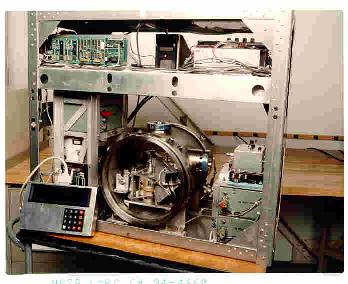Microgravity Droplet Combustion
Drop Tower Experiments and Numerical Modeling
Drop Tower Experiments and Numerical Modeling
 Research Summary
Research Summary
By conducting isolated droplet combustion experiments in drop towers, it is possible to generate low gravity conditions (<10-6) and spherically symmetric droplet combustion conditions which can be modeled using detailed chemical kinetics and multi-component transport. Experiments are conducted in the 2.2 second drop tower facility , and the Zero Gravity Facility at NASA Lewis Research Center in Cleveland, OH. All experimental activities (droplet growth, deployment, ignition and, combustion are completed in low-gravity conditions. Typically droplet sizes from 1.0 to 3.0 mm in diameter can be studied. Test results are utilized to develop hardware for space-based experiments, to refine models for predicting the resource and time requirements for such tests. Space-based experiments can study droplet sizes up to 6.0 mm.
 Typical 2.2 Second Drop Tower Results - Methanol Droplets
Typical 2.2 Second Drop Tower Results - Methanol Droplets
Methanol and methanol/water droplet combustion experiments have been conducted using the 2.2 second drop tower at NASA Lewis Research Center in Cleveland, OH. Experiments have been conducted in O2/N2 and O2/He environments at various pressures. The methanol droplet combustion apparatus used in the 2.2 second drop tower experiments is shown here:
The following is a sequence of video images from a methanol droplet combustion experiment conducted using the above apparatus. As the following images show, the droplet is grown between two hypodermic needles which are rapidly retracted thereby deploying the droplet into the microgravity environment. The gas phase surrounding the liquid droplet is ignited symmetrically using two hot wire igniters.



The previous images of methanol droplet combustion in microgravity were obtained with a standard VCR camera. Notice that, in the final frame, the flame is indeed spherically symmetric and, since methanol does not produce soot, it emits very little visible light.
In the experiment shown at left, the flame images has been acquired using an intensified array CCD camera fitted with an ultraviolet lens and a band-pass filter centered at 305 nm. This wavelength corresponds to emission from electronically excited hydroxyl radicals present within the flame. Comparisons between experiments and detailed kinetic modeling show that the location of maximum OH* emission coincides closely with the location of maximum temperature within the flame. Thus, chemiluminescent light emission measurements and modeling of the emission processes permits quantitative interpretation of flame properties including position and structure.
 Numerical Modeling
Numerical Modeling
A time-dependent, moving finite element model has been developed to simulate the spherically symmetric combustion of single and multi-component liquid droplets in microgravity. The model includes detailed chemical kinetics and multi-component molecular transport in the gas phase. In the liquid phase, the conservation of energy and species are solved. To date, the microgravity combustion of pure heptane, pure methanol, methanol/water mixtures, and heptane/hexadecane mixtures have been successfully simulated. The calculations compare favorably with experiments in terms of droplet burning rates, flame positions, and extinction diameters. Recently, an OH* chemiluminescence sub-model and a non-luminous thermal radiation sub-model have been added to the model.
Methanol and Methanol/Water Mixtures

Heptane and Heptane/Hexadecane Mixtures

OH* Chemiluminescence Model

A procedure has been developed to use hydroxyl (OH) radical chemiluminescence measurements along with numerical modeling to determine flame position and gain further insight into the structure of microgravity droplet flames. To validate this procedure, microgravity n-heptane and methanol droplet combustion experiments have been conducted. The spontaneous emission from electronically-excited hydroxyl radicals (OH*) within the envelope diffusion flame was measured using a UV-sensitive video camera (see above). Chemical reactions describing the production, emission, and quenching of OH* were incorporated into the droplet combustion model. The modeling and experimental results indicate differences in the route of OH* production between n-heptane and methanol flames. In both cases, the location of maximum OH* emission intensity is very near the location of maximum flame temperature suggesting that OH* imaging is a good approach to measure the flame position and structure.


 Science Support for Space-Based Droplet Experiments
Science Support for Space-Based Droplet Experiments
The experiments and modeling conducted in the Laboratory of Prof. Dryer at Princeton provide scientific support for droplet combustion research in conducted at NASA-Lewis Research Center in the 2.2 second and ZGF 5.18 second droptowers, as well as aboard the Space Shuttle. The first type of shuttle experiment is termed the Fiber Supported Droplet Combustion(FSDC) Experiment. This experiment is designed to be operated within the Glove Box Facility. The FSDC experiment was first flown as FSDC-1 aboardUnited States Microgravity Laboratory-2 (USML-2) launched on October 20, 1995 on Space Shuttle Columbia mission STS-73. A second fiber-supported droplet combustion experiment, FSDC-2,was to operate on Microgravity Science Laboratory-1 (MSL-1), launched aboard STS-83 Space Shuttle Columbia mission launched April 4, 1997. However, the mission was curtailed from 16 days to approximately 5 days by malfunction of one of three fuel-cell systems aboard the orbitor. The operation of this experiment was precluded altogether by the shortened mission.
The second type of Shuttle experiment supported by Princeton is called the Droplet Combustion Experiment (DCE). The first flight of this facility experiment was as part of MSL-1 aboard the STS-83 launched April 4, 1997. This experiment successfully operated during the curtailed mission to achieve the first observations of free-floating, isolated droplet combustion in space. A re-flight of the MSL-1 mission was launched July 1, 1997. As of the update of this page, both FSDC-2 and DCE experiments are operating well. Over twenty five successful FSDC-2 experiments have been performed thus far, using methanol, 30% water/70% methanol, 15% water/85% methanol, ethanol, 4% water/ 96% ethanol as fuels. More than 20 DCE experiments have been performed with a about the expected probability of success (> 50%). See the STS-94 Summary Page for further information.
Future flights of both experimental configurations for studying droplet combustion are currently being planned, and droplet combustion research is also continuing in the NASA-Lewis drop towers.






